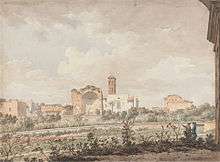William Pars

William Pars ARA (28 February 1742 – 1782) was an English watercolour portrait and landscape painter, draughtsman and illustrator.[1]
Life and works

Pars was born in London, the son of a metal engraver. He studied at "Shipley's Drawing School" (in the Strand), St. Martin's Lane Academy, and also in the Duke of Richmond's Gallery.[2] In 1761, at the age of 17, he exhibited a portrait and miniatures at the Incorporated Society of Artists, and became a member of the Free Society of Artists in 1763. In 1764 he obtained the Society of Arts' medal for an historical painting.
In June 1764, he was selected by the Dilettanti Society to accompany, as draughtsman, Richard Chandler and Nicholas Revett to Greece. The result was published in 'Ionian Antiquities' (4 volumes) which was illustrated from Pars's drawings.[3]
Pars returned to England on 2 December 1766, and soon after accompanied Henry Temple, 2nd Viscount Palmerston to the continent, making drawings in Switzerland, the Tyrol, and Rome. In 1769 he contributed seven views from Greece to the first exhibition of the Royal Academy. He was elected an associate in 1770, and in the following year he sent eight European views, chiefly of Switzerland and the Tyrol, together with one portrait. He contributed regularly (chiefly portraits) to the academy exhibitions till 1776.

In the summer of 1775 he travelled to Rome on a bursary of the Dilettanti Society, where artists such as John Warwick Smith, Francis Towne (a friend of Pars, who took some instruction in drawing from him)[4] John Robert Cozens and Thomas Jones were working.[5] He remained there till the autumn of 1782, when he died of pleurisy (his wife having died in the city in June 1778).[5][6]
A selection of Pars' Greek drawings was engraved by William Byrne for the Dilettanti Society; five of his Swiss drawings, including the 'Mer de Glace were engraved by William Woollett; and several other drawings were aquatinted by Paul Sandby.
Pars' elder brother Henry Pars (1734–1806) was a draughtsman and metal engraver, becoming the Principal of "Shipley's Drawing School".[6]
See also
- James Stuart (1713–1788). Like Pars, he also recorded antiquities in Greece and accompanied Nicholas Revett on tours.
References
- ↑
 Lee, Sidney, ed. (1895). "Pars, William". Dictionary of National Biography. 43. London: Smith, Elder & Co. p. 394. .
Lee, Sidney, ed. (1895). "Pars, William". Dictionary of National Biography. 43. London: Smith, Elder & Co. p. 394. . - ↑ Likely to have been in Richmond House, Whitehall, London. Built in 1736, destroyed by fire in 1791. See
- ↑ Ionian Antiquities (Moby's Newt Ltd.).
- ↑ H. M. Cundall. Masters of Water-Colour Painting (London: The Studio Ltd, 1922-23).
- 1 2 Matthew Hargraves. Great British watercolors: from the Paul Mellon collection at the Yale (Yale University press, 2007) p34 ff.
- 1 2 Biography (arts.jrank.org).
External links
| Wikimedia Commons has media related to William Pars. |
- William Pars online (ArtCyclopedia)
- Biography (handprint.com - scroll down page)
- Biography and works ("History of Art")
- William Pars, A Sepulchral Monument at Mylasa
- St Peter's Rome (1770s Watercolour - V&A)
- Profile on Royal Academy of Arts Collections